Use 'Print preview' to check the number of pages and printer settings.
Print functionality varies between browsers.
Printable page generated Friday, 26 April 2024, 10:29 PM
Study Session 14 Water Emergencies and Emergency Water Supply
Introduction
Safe and reliable drinking water has always played a prominent role in the development of human civilisation. Water was, and continues to be, a basic necessity of human survival. However, access to safe, adequate and reliable water is not always present. There may be emergencies in the water supply system that result in a break in supply. Distribution of fresh water can also be a challenge when natural disasters (such as droughts, floods, earthquakes, etc.) or accidents occur, or during catastrophes caused by human actions such as wars, when a displaced population has to be supplied with water. You will look at examples of these situations in this study session and learn about water supply during emergencies in urban areas, and how emergency water supplies can be set up for populations that have been displaced.
Learning Outcomes for Study Session 14
When you have studied this session, you should be able to:
14.1 Define and use correctly all of the key words printed in bold. (SAQ 14.1)
14.2 Give typical examples of emergencies that can occur in an established water supply system, and how safe water can be supplied in these situations. (SAQ 14.2)
14.3 Identify home water treatment methods that can be used during water emergencies. (SAQ 14.3)
14.4 Describe situations where emergency water supplies would be needed. (SAQ 14.4)
14.5 Describe ways in which water can be rapidly obtained and treated for emergency water supply. (SAQ 14.5)
14.1 Causes of emergency situations
Emergencies are sudden, unexpected, hazardous situations where there is a need for an immediate response. They can cause severe disruption because they are unexpected. Resources are needed to cope with an emergency and they may have to be brought in from outside.
Everyone will have to deal with emergencies in life at some time or another. Can you think of an emergency that has occurred in your life? You can probably think of many. The last one that I had was when a pipe burst in my mother’s house. It was late in the night, and I had to take my friend Kabede with me (as an outside resource) to help fix it, because I am useless at plumbing.
A water emergency, such as the one described above, is an event that disrupts the normal supply of water. In town, it can occur due to natural causes or when there is damage to the major infrastructure of the treatment plant, water storage or water distribution system. Untreated or partially treated water may be inadvertently distributed in an emergency situation.Another cause of a water emergency could be contamination of the water supply, for example by a chemical leak.
As you can see, there are several different types of emergency that can affect water supply and some of these are described in the sections that follow.
14.1.1 Drought
A drought occurs when there is a deficiency in precipitation over an extended period of time, resulting in a water shortage. You are probably familiar with the consequences of a drought. The lack of rain means that the water flow in rivers is reduced, lakes and pools shrink in size or may dry up, groundwater and soil moisture are depleted, and crops are damaged. Prolonged drought can lead to a major national and regional food insecurity crisis. Domestic animals might also die (Figure 14.1).
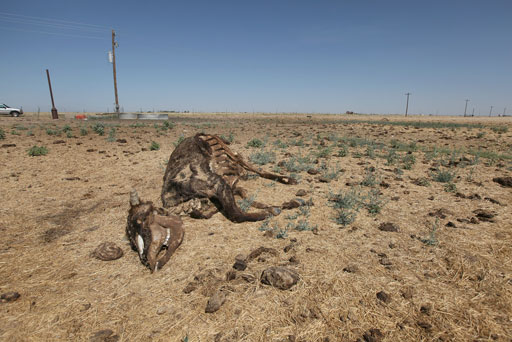
Ethiopia has been associated with drought for a long time and many people have suffered from its effects. For example, in the drought of 1985 in the northern part of the country, an estimated 800,000 people died due to malnutrition and disease.
During a shortage of fresh water during a drought, people may be forced to use unprotected water supplies. Furthermore, people and animals may use the same water source, which increases the risk of contamination of that particular water source. This leads to increased exposure to waterborne diseases (such as diarrhoea and dysentery) and water-washed diseases (such as trachoma).
14.1.2 Flooding
Flooding is an abnormal rise in the water level and may result in overflowing of streams or rivers.Flood waters can destroy infrastructure, including houses, roads and water supply systems, as well as agricultural crops, which ultimately causes a shortage of food supplies in the country. Besides the destruction of property, people and animals may be killed, especially when flash floods occur. (A flash flood happens when rain falls so fast that the underlying ground cannot drain the water away fast enough and rivers overflow their banks. Roads can then become like rivers and if there is a lot of water it can flood buildings and carry cars away.)
Floods can cause widespread bacterial contamination of wells and surface water sources with faecal matter washed from the ground surface or from flooded latrines and sewers, resulting in the outbreak of disease. For example, cholera commonly occurs after flooding.
14.1.3 Earthquake
An earthquake can cause serious damage to infrastructure on and in the ground (Figure 14.2). Pipes and treatment plants will be destroyed by a high-magnitude earthquake and the communication systems (such as road and rail networks) often become non-functional, making the delivery of emergency water supplies difficult. Destruction during an earthquake can also cause chemical spillage at manufacturing plants and warehouses, which can lead to widespread chemical contamination of drinking water.
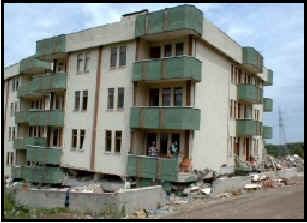
14.1.4 Events caused by human intervention
It is possible that a deliberate attempt could be made to poison a water supply as an act of terrorism, but it is far more likely that human causes of water emergencies will be due to accident and neglect. There can be instances where the water supplied will be unfit for human consumption as a result of an accident – Box 14.1 describes such a case at a water treatment works in the United Kingdom.
Box 14.1 An example of a human-caused water emergency in the UK
In July 1988 in Camelford, a small town of 20,000 people in south-west England, 20 tonnes of aluminium sulphate was dumped into the wrong tank at the local water treatment plant (Figure 14.3) by a chemical tanker driver who was not familiar with the plant layout and delivery procedures.Aluminium sulphate went directly into the mains water supply, and this became the worst water poisoning incident in Britain. Residents complained because the water coming out of the tap was black, and curdled the milk in their tea. One man described how his hair had stuck together after he took a bath, as if his head had been smeared with glue. Symptoms such as stomach cramp, diarrhoea, skin rashes, joint pain, sore throat, short-term memory problems and general exhaustion were reported.
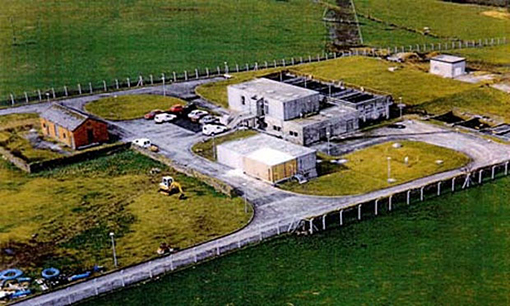
Aside from accidents, human neglect is the other most likely cause of a water emergency. Case Study 14.1 illustrates how neglect can lead to a water crisis, although it does not fit the definition of an emergency because it was not sudden.
Case Study 14.1 Water supply in Harar
Harar is a city in the eastern part of Ethiopia, 505 km from Addis Ababa. The city used to get water from Lake Alemaya (Haromaya), but since February 2004 the supply has ceased.
The water treatment plant at the lake was originally designed to serve a population of 70,000 but in 2000 the plant was supplying 160,000 people, who lived in Harar City, two small towns and at Haramaya University.
Lake Alemaya (Figure 14.4) has at its edge the town of Alemaya to the south and southwest, Haramaya University to the east, and farming communities to the north and northwest. In the mid-1980s its maximum depth was around 8 m and it covered an area of 4.72 km2. It was an attractive freshwater lake used for drinking water, irrigation, fishery and recreation. Farmers in the surrounding community used a tremendous amount of fertiliser to grow different crops, in addition to khat, and excess fertiliser used to end up in the lake. Wastes containing chemicals from the town were dumped at the shore of the lake in indiscriminate and irresponsible ways.

The depletion of water from the lake started slowly and no protective conservation measures were taken by anyone, although it was plain that the water level was dropping year on year.
After the water had nearly gone, the city faced a serious water shortage and water rationing was introduced. Responding to the acute water shortage in Harar, many individuals in central government and non-governmental organisations were involved in a programme to combat the emergency. Water tankers were used to transport water to the town dwellers from distant available sources (Figure 14.5). This emergency operation continued for more than a year until deep wells were dug 20 km away to supply water to the residents again.
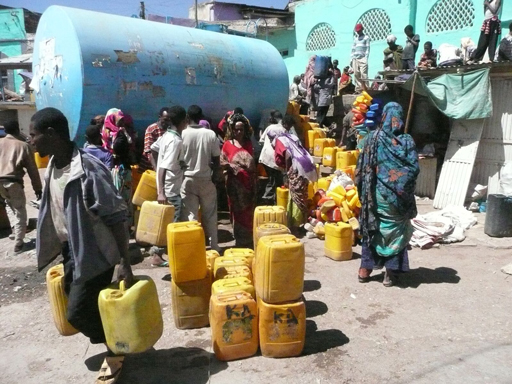
14.2 People affected by emergencies
Catastrophic emergencies like floods and earthquakes will affect everyone, but the poor and vulnerable will always be at a disadvantage. In many situations, the people most likely to be severely affected are internally displaced people and refugees. In situations of war and conflict people naturally want to escape and so they move in large numbers away from the conflict zone. The places they arrive at frequently have no infrastructure and very limited resources.
Internally displaced people are people who are forced to flee their homes due to circumstances such as natural disasters or war, but who remain within their own country's borders. For example, during 2014, internal war and conflictcaused thousands of people in the Central African Republic, Southern Sudan and Syria to flee their homes and move elsewhere in their country. Such events call for a fast and coordinated effort to provide basic services such as shelter, food, water, latrines, handwashing facilities, etc.When providing shelter, the choice of location is often dependent on the availability of water.
Conflictsof this kind can also result in people seeking refuge outside their own country. For instance, in 2015, there were more than 600,000 Syrian refugees in Jordan who had fled the conflict in their home country (UNHCR, 2015). Camps had to be set up in the desert, and of course the supply of water was crucial.
14.3 Waterborne disease outbreaks caused by emergencies
A disease outbreak is the occurrence of cases of disease greater in number than would normally be expected in a defined community, geographical area or season. A waterborne disease outbreak is therefore another type of emergency situation. It might be caused by one of the natural disasters described in the last section, or due to human error, or indeed both. The greatest risk of waterborne outbreaks is pollution of water sources by faecal pathogens. This might occur due to inadequate sanitation, poor hygiene or lack of protection of water sources.
Cholera, caused by Vibrio cholerae, is a disease that is frequently associated with disasters and emergencies, where the breakdown of normal procedures and the collapse of infrastructure create conditions that lead to faecal contamination of water. This was the situation on the island of Haiti following the earthquake there in 2010.
Case Study 14.2 Cholera outbreak in Haiti
In Haiti in October 2010, ten months after a devastating earthquake, an outbreak of cholera began in an area about 100 km from the capital, Port-au-Prince. This was the first instance of cholera in Haiti for at least 100 years and by March 2011 it had killed 4672 people and thousands more were hospitalised (Figure 14.6). By March 2012, a further 2378 people had died, and more than 531,000 people had been taken ill. Furthermore, the disease spread to neighbouring countries like the Dominican Republic and Cuba.
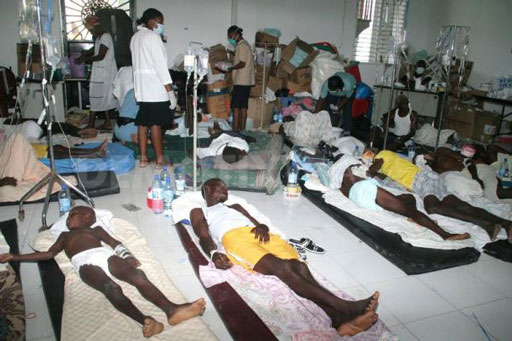
The suspected source of the epidemic was the Artibonite River (Haiti’s longest and most important river), with which most of those who had caught the disease had been in contact. The river water was used for washing, bathing, drinking, irrigation and recreation. Along one of the tributaries of the Artibonite River was a United Nations military base for peacekeeping troops from Nepal. This came under suspicion as the source of the contamination of the river due to sewage from the base entering the river. The UN appointed a panel to investigate the source of the outbreak and they confirmed evidence that the particular strain of Vibrio cholerae isolated in the cholera cases found was similar to that circulating in South Asia, including Nepal (Cravioto et al., 2011). This suggested that the UN peacekeeping force was indeed the source and the investigation led many people to blame the UN for the cholera outbreak (Figure 14.7).

In the years after the outbreak, medical efforts and preventive measures (such as the installation of more latrines) and changes in behaviour (for example, cooking food thoroughly and rigorously washing hands after using the toilet) brought the number of cholera cases down. The toll by November 2013 was 8448 killed and 689,448 taken ill (Pan American Health Organization, 2013).
The UN-appointed panel came up with seven recommendations in their report and two of these were related the cause of the outbreak (United Nations, 2011):
- UN personnel from countries that have cholera and who respond to emergencies in countries where cholera is not common should take antibiotics to prevent the disease before departure and/or be screened to confirm that they are not carrying Vibrio cholerae without suffering the disease.
- UN installations worldwide should treat faecal waste using on-site systems to inactivate pathogens before disposal. These systems should be operated and maintained by trained, qualified UN staff or by local providers with adequate UN oversight.
14.4 Treatment options for water emergencies
The purpose of water treatment in emergency situations is the same as it is in any circumstance, which is to remove all types of contaminants present in the water and to improve the quality to a level safe for human consumption. The difference in emergency situations is that the normal structures and processes are not available.
In acute emergency situations where speed of providing water for people is paramount, the main options for water supply are distribution of safe water to people through the use of water tankers and/or plastic bottles. The other option is to give the water consumers the means of treating water for themselves to render it safe. You learned about the methods that could be used in Study Session 10.
Briefly describe the main processes of household water treatment and give examples of the methods that could be used.
The main processes are sedimentation or filtration, both of which remove solids, and disinfection to kill pathogens. Some examples of filtration methods are cloth filtration, sand filtration, and ceramic filtration. For disinfection methods you could have said boiling, solar disinfection, and chemical disinfection using products such as Wuha Agar, Bishan Gari, Aquatabs and P&G Purifier of Water.
If it is not possible to filter the water, and if the water treatment chemicals mentioned above are not available, then the water should be kept in a container to settle any solids and then decanted out. The decanted water should then be boiled.
14.4.1 Water treatment and distribution
For the longer-term needs of displaced people and refugees, the population should, if possible, be located in an area where there is adequate groundwater. This type of water normally requires minimal treatment before consumption – usually just disinfection, in order to keep the water safe from microbial contamination. Failing this, surface water from rivers or lakes can be used, but these waters will require a greater degree of treatment, since the level of suspended solids in them is likely to be high. Disinfection will again be needed.
One way of achieving this is with an emergency water treatment system that replicates the processes of a full-scale permanent water treatment works. A relatively simple process for emergency water treatment is available (Figure 14.8) and can be constructed in a matter of a few hours (Oxfam, 2014a). The tanks can be set up and operated by a team of seven (an experienced water engineer and six technicians). It is important for sustainability in an emergency that simple systems are used.
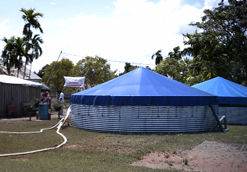
In this system, the raw water is dosed with aluminium sulphate coagulant (which is easily obtained in most countries of the world) and left to flocculate and settle for six hours in 45-m3 sedimentation tanks. It is then chlorinated (using a solution of calcium hypochlorite) and sent with a residual chlorine level of about 0.5 mg per litre (0.5 mg l–1) to the distribution system made up of PVC pipes laid above ground (to bury them would take time) and standpipes. The treatment system can produce 180 m3 of clean water a day. Once a week or so, the residual chlorine level is increased to 1 mg l–1 so that the water containers used by the people are disinfected.
How many people could 180 m3 of water support per day, if the water requirement is 20 litres per person per day?
180 m3 is 180,000 litres. If one person needs 20 litres of water a day, 180 000 litres will be enough for (180,000 / 20) = 9000 people.
A more complex water treatment system (Figure 14.9), which uses coagulation and flocculation, sand filtration, microfiltration (where a membrane filters out particles which are 0.05–0.5 µm in size) and chlorination, is available (Oxfam, 2014b). This requires a team of three – an experienced water engineer and two technicians. The unit can produce up to 4 m3 of clean water an hour.
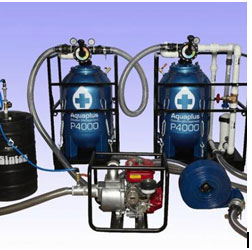
Summary of Study Session 14
In Study Session 14, you have learned that:
- Water supplies may be cut off in emergencies caused by natural events or human actions. Natural factors could be droughts, floods or earthquakes, while human-related emergencies can arise from accidents caused by human error, deliberate poisoning of the water supply or neglect (as exemplified by Case Study 14.1).
- During emergencies water may be supplied via delivery by tankers, use of plastic bottles or treatment of available poor-quality water in the home using filtration and disinfection.
- Filtration at household level can be achieved by using cloth, sand or a ceramic pot. Disinfection can be undertaken by boiling or solar methods, or by using chlorine or commercial water treatment products.
- Emergency water treatment is needed when an internally displaced population or refugees have to be provided with water urgently. It is preferable to use groundwater as it is likely to be less polluted than surface water.
- Simple and complex systems for emergency water treatment are available. For sustainability simple systems are preferable.
- The coagulant most commonly used in emergency water treatment is aluminium sulphate, as it is widely available. A simple emergency water treatment system comprises coagulation and flocculation, sedimentation, and chlorination, while a complex unit might incorporate coagulation and flocculation, sand filtration, microfiltration, and chlorination.
Self-Assessment Questions (SAQs) for Study Session 14
Now that you have completed this study session, you can assess how well you have achieved its Learning Outcomes by answering these questions.
SAQ 14.1 (tests Learning Outcome 14.1)
Match the following words to their correct definitions.
Using the following two lists, match each numbered item with the correct letter.
internally displaced people
flooding
disease outbreak
microfiltration
water emergency
emergencies
drought
flash flood
a.an unexpected rise in the number of cases of a disease
b.an event that disrupts the normal supply of water
c.sudden, unexpected, hazardous events
d.short-duration flooding that occurs due to sudden heavy rainfall that is unable to drain away into the ground
e.an abnormal rise in water level that can cause damage
f.a means of separating from water particles that are 0.05 to 0.5 µm in size
g.people who have been forced to flee to another part of their own country due to factors beyond their control
h.a deficiency in precipitation that lasts for a long period of time
- 1 = g
- 2 = e
- 3 = a
- 4 = f
- 5 = b
- 6 = c
- 7 = h
- 8 = d
SAQ 14.2 (tests Learning Outcome 14.2)
- a.Give six possible causes of water emergencies, three due to natural causes and three due to humans.
- b.What are the options for safe water supply during a water emergency?
Answer
- a.Three possible natural causes of water emergencies: drought; flooding; earthquakes.
Three possible causes of water emergencies due to humans: accidental contamination of the water supply (as in the Camelford incident); microbial contamination of water sources due to human mismanagement (such as the cholera outbreak in Haiti); deliberate poisoning of the water supply as an act of terrorism.
- b.The possible options for safe water supply during a water emergency are:
- delivery of water to consumers by water tanker and/or bottles
- treatment of the water at the household to render it safe (e.g. by boiling).
SAQ 14.3 (tests Learning Outcome 14.3)
- a.What are the two treatment steps needed in household water treatment during a water emergency?
- b.For each of the two steps referred to above, suggest three possible options.
- c.There are two formulations available in Ethiopia for household water treatment that contain both a coagulant/flocculant and a disinfectant. What are these?
- d.What are the steps to follow if filtration cannot be undertaken and no water treatment chemicals are available?
Answer
- a.The two treatment steps needed in household water treatment during a water emergency are filtration and disinfection.
- b.Three options for filtration: cloth filtration, household sand filtration and ceramic filtration.
Three options for disinfection: boiling, solar disinfection and chlorination. (Other possibilities are the use of commercial products such as Bishan Gari, Aquatabs or P&G Purifier of Water).
- c.Bishan Gari and P&G Purifier of Water.
- d.The solids in the water should be settled out and the water boiled before consumption.
SAQ 14.4 (tests Learning Outcome 14.4)
Which of the following are not likely to require an emergency water treatment and supply system? Give your reason why in each case:
- a.A temporary camp housing people who have been displaced within their own country due to an earthquake.
- b.People who live in a residential area in a city.
- c.Refugees who have fled to cities in a neighbouring country due to fighting in their own.
- d.Refugees living in an uninhabited area of a neighbouring country.
Answer
The answer depends on the type and extent of the emergency but you may have identified the following groups of people.
- b.People who live in a residential area in a city – it is likely that a piped water system exists in such an area, so an emergency water treatment and supply system would not be needed.
- c.Refugees who have fled to cities in a neighbouring country due to fighting in their own – most cities will have piped water systems in place.
SAQ 14.5 (tests Learning Outcome 14.5)
- a.List the stages of water treatment for an emergency water supply based on a water source where the level of suspended solids is high.
- b.How will the raw water be obtained?
- c.Name the coagulant and disinfection agents that are most commonly used in emergency water treatment.
- d.Why is the residual chlorine level in an emergency water supply raised to 1 mg l–1 about once a week?
Answer
- a.The stages of water treatment for an emergency water supply based on a water source where the level of suspended solids is high would be: addition of coagulant, sedimentation and chlorination.
- b.The raw water will be obtained from groundwater sources if available, as this will usually require only minimal treatment. The second option would be to use surface waters (for example, from a river or lake).
- c.The coagulant and disinfection agents that are most commonly used in emergency water treatment are aluminium sulphate and calcium hypochlorite, respectively.
- d.The residual chlorine level in an emergency water supply is raised to 1 mg l–1 once a week in order to disinfect the water containers used by the people served by the supply.